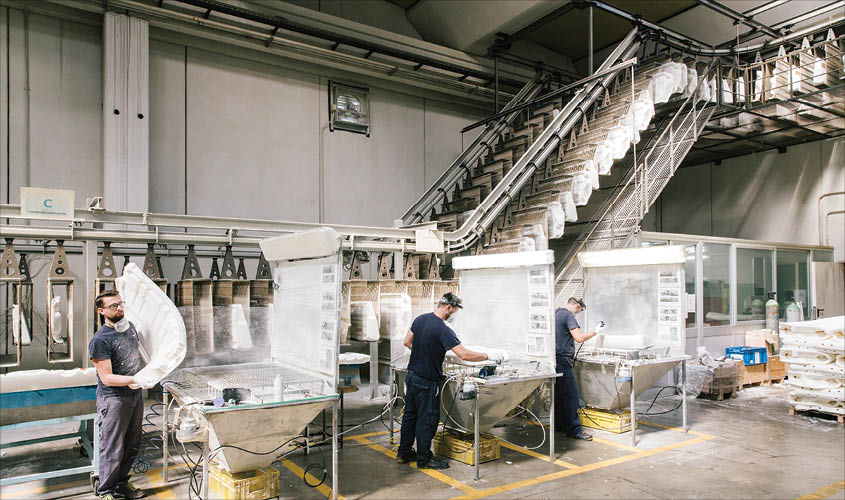When a debt crisis slammed the eurozone nearly a decade ago, Germany’s powerhouse economy helped lift troubled neighbours like Greece, Portugal and Spain above the turmoil. The question that Europe faces now is whether those countries are strong enough to return the favour.
Germany is on the brink of recession after its economy declined in the year’s second quarter. Spain, by comparison, is experiencing brisk growth, and even the Portuguese and Greek economies are expanding. Buoyed by tourism, booming construction and steady job growth, the southern European countries are helping to offset Germany’s weak performance.
But will it be enough? As the US economy appears to slow, China loses momentum and Brexit looms, can Europe dodge a downturn?
The question may be decisive for Europe and crucial for the United States. The European Union and the United States are each other’s biggest trading partners, and a slowdown in Europe would be another drag on America’s economy at a time when bond markets are already flashing warning signs.
Most economists are not yet predicting a Europewide recession, but they are worried about the prospect. There is little chance that the European Union can thrive when Germany is sickly.
“If the largest member state is affected,” said Katharina Utermöhl, senior economist at German insurer Allianz, “this will also start to weigh on the euro area as a whole because of the close economic relations.”
Should Europe sustain more economic body blows, like a no-deal Brexit, a debt meltdown in Italy or an escalation of the trade war, Utermöhl said, “The risk of a recession is rather high.”
Some economists are more pessimistic.
“Euroland is headed for a recession,” Carl Weinberg, chief international economist at High Frequency Economics, a research consulting firm in White Plains, New York, said in an email Friday. “All the writing is on the wall.” Weinberg cited numerous indicators of trouble: less production at eurozone factories, surveys showing increasing gloominess among business managers and a contraction in global trade.
The perilous state of the eurozone economy will be an early test for Christine Lagarde when she succeeds Mario Draghi as president of the European Central Bank in October. Draghi is expected to announce a new package of stimulus measures next month, but Lagarde will have to consider what the central bank can do if the situation gets worse.
When Germany’s official statistics office reported Wednesday that the economy shrank 0.1% in the second quarter, shock waves rippled through stock markets around the world. The reaction reflected the degree to which Germany sets the tone for the Continent.
Germany has the eurozone’s biggest economy, accounting for more than a quarter of the bloc’s output. It has the most people, 83 million, and the most workers, who help stoke nearly every other country’s economy. The number of European Union countries that count Germany as their No. 1 trading partner is long. It includes France, Italy, the Netherlands, Belgium, Slovakia and Sweden.
The relationships sometimes border on dependency. Germany accounts for 27% of Poland’s foreign trade. Britain, Poland’s No. 2 trading partner, accounts for only 6%, according to World Bank data.
Suppliers throughout Europe earn much of their revenue by selling to big German manufacturers like Daimler, Siemens and ThyssenKrupp. But those companies are struggling.
Daimler, maker of Mercedes-Benz cars, has issued three profit warnings since October. Siemens, whose products include high-speed trains and equipment for oil and gas producers, this month reported a 6% decline in net profit. And ratings firm Moody’s this week downgraded ThyssenKrupp’s debt further into junk territory, an indication that the giant steelmaker is considered a default risk.
As it strains against the German downdraft, Europe is battling a host of other woes. High on the list is Italy, which has a stagnant economy, an unstable government and one of the highest debt burdens in the world, giving it the potential to touch off another financial crisis.
Another risk is that Britain will leave the European Union without a deal with Brussels, creating chaos in the flow of goods across the English Channel. And car sales are plunging around the world, threatening an important source of jobs in countries like Italy, France and Slovakia.
The biggest squeeze comes from the trade war. President Donald Trump’s tariffs on a range of Chinese imports and on European steel and aluminum have disrupted supply chains and profoundly unsettled managers who make decisions about how much money to invest in new factory space and how many people to hire.
Germany is especially vulnerable to trade tensions because exports account for almost half of the country’s gross domestic product. And it is most sensitive to the downturn in the auto industry because vehicles are the country’s biggest export. Sales of German cars have slumped as Chinese buyers pull back.
It can be difficult to gauge how deeply other individual economies are rattled by the trade war, but the latest numbers across Europe, released Friday, contained troubling signs. Eurozone exports fell 5% in June, the European Union’s official statistics agency reported. Trade accounts for about one-third of the bloc’s gross domestic product.
Eurozone growth has already been meager this year. The 19 countries in the currency bloc collectively grew 0.2% from April through June. The European Union, which includes the eurozone plus nine other countries, recorded the same rate.
Spain was one of the best performers, registering a growth rate of 0.5% compared with the previous quarter that helped to balance out Germany’s 0.1% decline in output. But Spain and other fast-growing countries like Denmark and Finland are not big enough to replace Germany as Europe’s economic
Even if Europe manages to avoid two consecutive quarters of declining output, the technical definition of a recession, no one expects growth to be particularly impressive.
“The slowdown in growth is everywhere in the eurozone, more or less,” said Jörg Krämer, chief economist at Commerzbank. “There is no decoupling.”
© 2019 The New York Times

